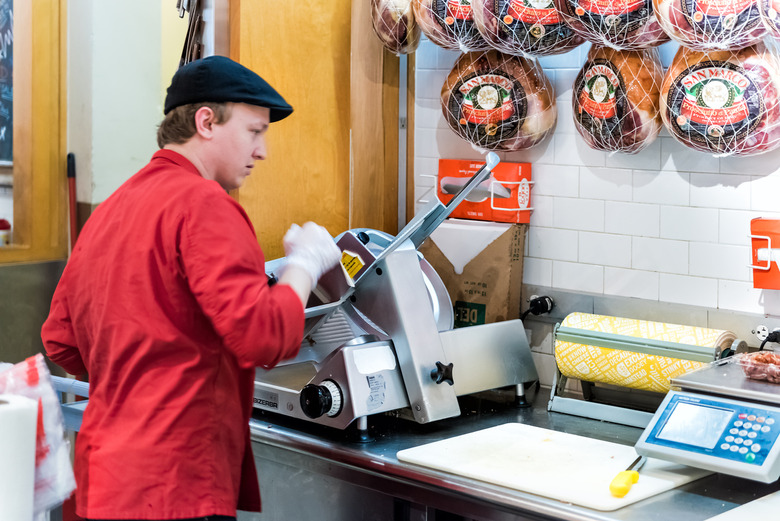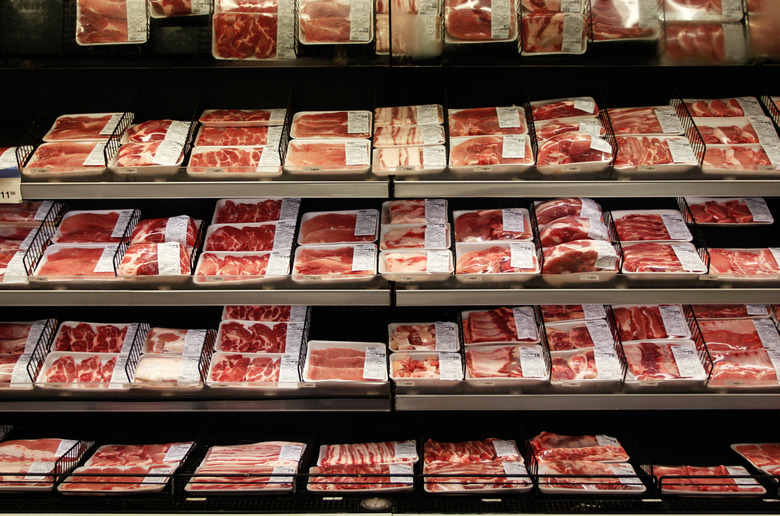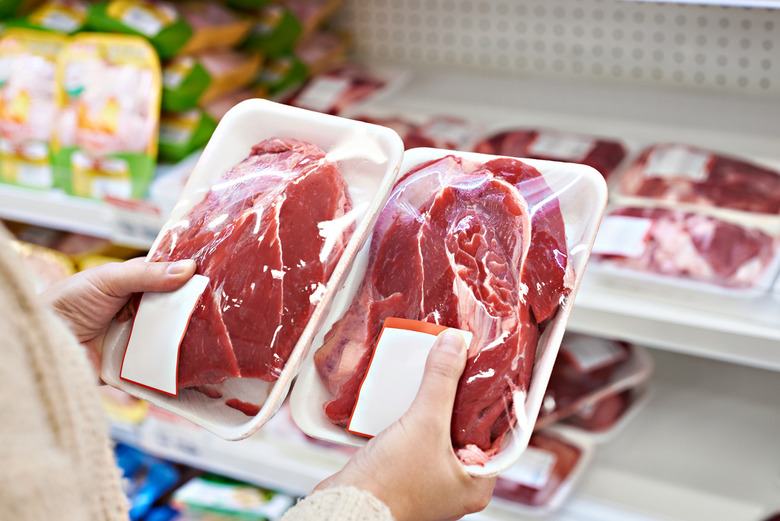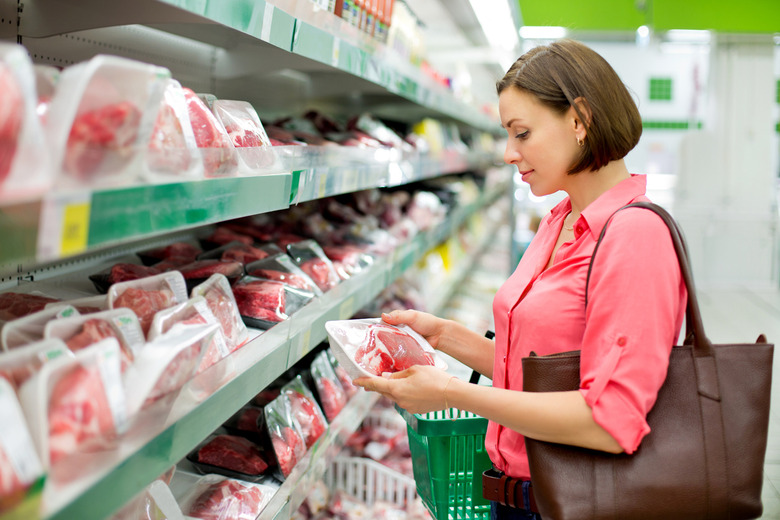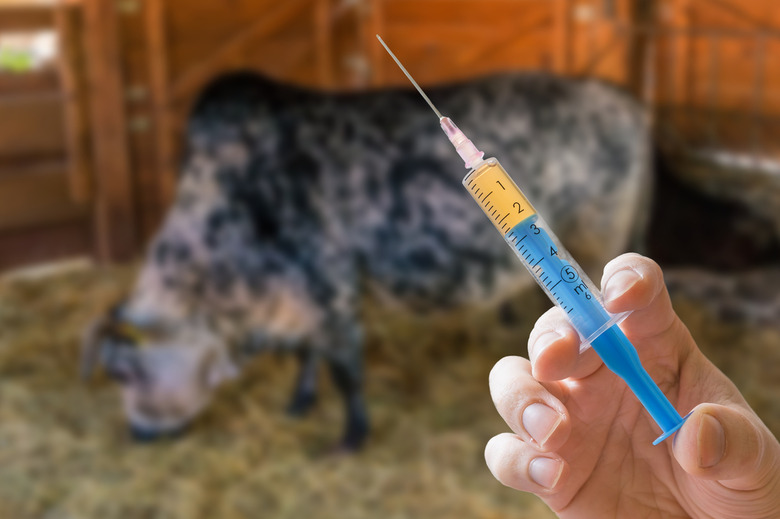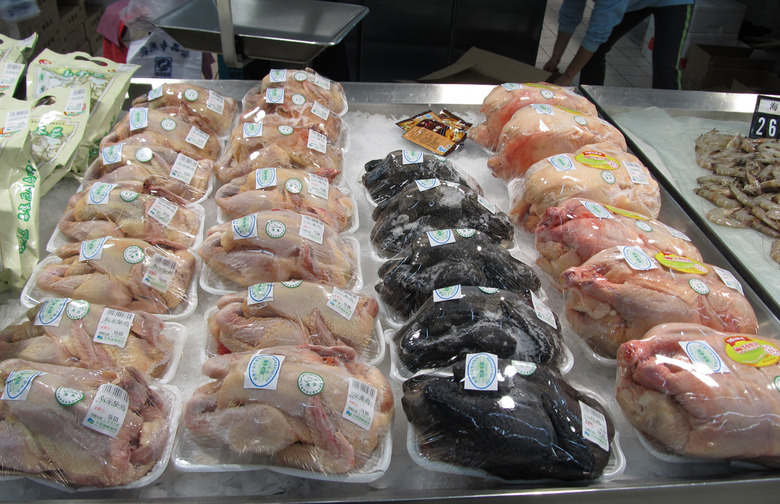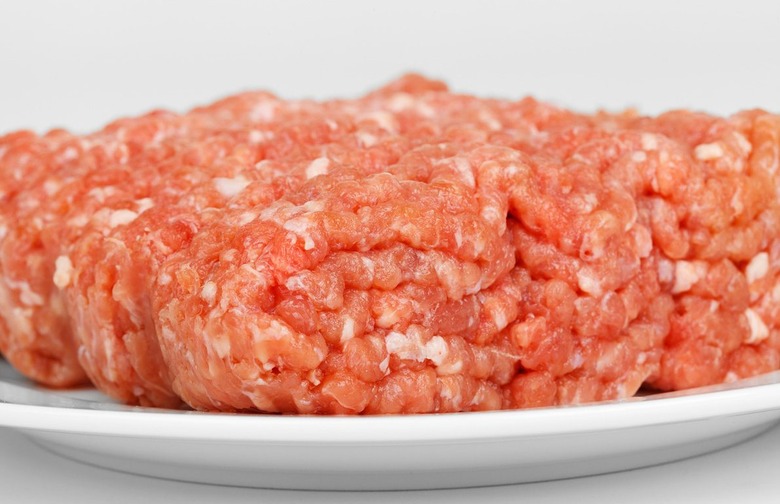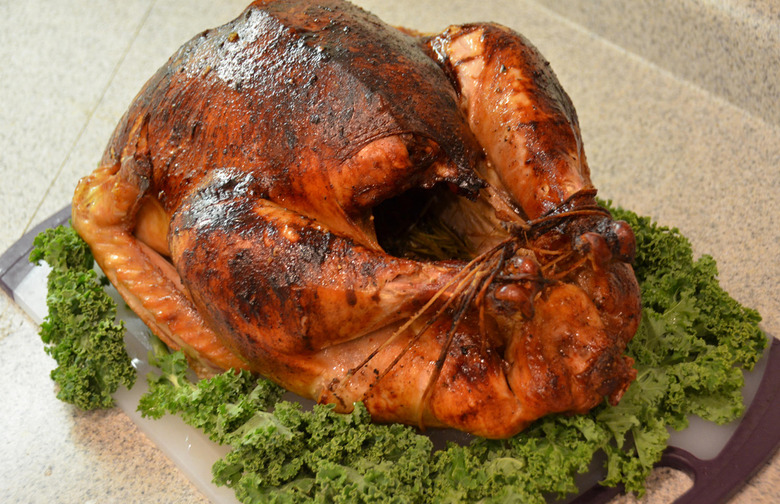19 Reasons Why You Might Want To Stop Buying Supermarket Meat
If you're like most Americans, you most likely buy your meat at the supermarket. Be it raw chicken and steaks from the butcher case or cold cuts from the deli counter, we tend to not give much thought to the meat we buy beyond whether it's fresh and how much it costs. But you might want to think twice before buying your next Styrofoam-and-cellophane-wrapped chicken breast, because what we're about to tell you may have you buying all your meat at the organic butcher shop from now on.
The Deli Slicer Is One of the Dirtiest Places in the Supermarket
The deli slicer, and the cold cuts that it slices, are at serious risk of contamination. If the blade isn't regularly cleaned, it can transfer bacteria (including listeria) to everything it touches. A joint team of researchers from the USDA, FDA, and CDC sampled deli meats at the point of purchase, and three percent tested positive for listeria. Thankfully, however, Listeria rates have declined more than 80 percent over the last decade and there has not been a recall due to listeria illnesses in ready to eat meat products in more than a decade.
The Packages of Raw Meat Can Be E. coli Farms
Raw meat can harbor E. coli, listeria, and plenty of other nasty pathogens. Plastic wrap isn't the best defense against the outside world. Ever picked up a package of raw chicken only to have it leak all over the other packages? That right there is how people get sick. While E. coli, listeria, and salmonella infection rates have decreased in recent years, it's always important to wash your hands after touching meat packages and make sure to cook it thoroughly.
The Fish May Be Mislabeled
The UDSA is actually pretty lax about testing meat to make sure it is what it says it is on the label, primarily because nobody is butchering horses in the U.S. and it's pretty easy to tell the difference between, say, beef and pork. Fish, on the other hand, is a different story. A recent study found that up to a third of all fish currently on the market is mislabeled, with expensive fish like tuna being replaced by others that look similar. While most of the counterfeit fish is safe to eat, some of it — like snake mackerel — can cause serious gastric issues.
Expiration Dates on Meat Packaging Are Generally Meaningless
We hate to break it to you, but expiration dates really don't mean much. Sure, Cheez-Its will go stale and milk will go bad a certain number of weeks after packaging, but supermarket meat departments, where they do their own labeling, are generally left up to their own devices (30 states don't regulate date labeling at all). This means that if an item is set to expire and it still looks okay, supermarkets are allowed to put a new label on, pushing the expiration date back by days or even more than a week. We suggest checking to see when the food first hit the shelf, if possible, or buying meat from a trusted butcher.
Meat in the Circulars Is Most Likely Not Actually on Sale
Those big newspaper inserts aren't actually intended to save you money. They're supposed to make you buy stuff you don't need just because you think they're on sale. Make sure you double check every coupon you're going to use; in some cases the price advertised is exactly the same as the non-coupon price!
It’s Full of Antibiotics
Because the stressful and dirty conditions at factory farms can wreak havoc on the animals' immune systems, livestock are treated with antibiotics both as preventative measures and for treatment of sick animals. Antibiotics can be bought by the pound at any farm store, while doctors' prescriptions are needed when a human needs them. According to a study by the Proceedings of the National Academy of Sciences, it's been estimated that livestock consumed more than 36,000 tons of antibiotics in 2010. Thankfully, Purdue went antibiotic-free in 2014, and medically-important antibiotics will only be available under veterinary prescription as of December 2016.
Almost Half Contains Staph Bacteria
According to a 2011 study published in the journal Clinical Infectious Diseases, researchers have found that almost half of all raw meat in American supermarkets contains staph infection bacteria, including MRSA, which is potentially lethal. Turkey, pork, and chicken products (in that order) were most likely to harbor staph.
Some Is “Mechanically Tenderized,” Which Can Be Dangerous
Certain tough cuts of meat are "mechanically tenderized" before they hit shelves to make them appear more tender — by being poked with hundreds of tiny needles to help break up the muscle fibers (it's usually impossible to see with naked eyes when this has taken place). What's wrong with making meat more tender, you may ask? While the inside of meat is sterile, dangerous (occasionally antibiotic-resistant) bacteria can thrive on its surface. Those needles drive the bacteria deep into the interior of the meat, contaminating the whole cut. Risk assessments by the USDA found no major difference in the safety of mechanically-tenderized meat from intact beef, but the products that have been mechanically tenderized will soon be labeled.
Supermarket Chickens are Pumped with Potentially Dangerous Drugs
In 2012, Johns Hopkins University studied the feathers of imported chickens to see what was in their system before slaughter. Painkillers, antidepressants, banned antibiotics, and caffeine were found in the samples. Some chickens were even fed Prozac; stress can slow their growth. And as for the caffeine? Chickens grow faster when they're awake. The National Chicken Council took issue with these findings (especially the fact that only feathers were tested); you can find their rebuttal here.
A Surprising Chemical Is Used to Make Meat Look Pink
When fresh meat has been sitting in a refrigerator for a couple days, it oxidizes and starts to turn a shade of grayish-brown, which doesn't look particularly appetizing, especially when shoppers are looking for shelves of bright red meat. In order to avoid having to throw away the meat, as much as 70 percent of all the raw meat sold in supermarkets is treated with a suspiring chemical: carbon monoxide. The gas interacts with the myoglobin in the meat, locking in the bright red color. Called "modified atmosphere packaging" by the factory farm industry, carbon monoxide has been shown to keep meat looking artificially fresh for up to a full year. The North American Meat Institute sheds more light on this practice here.
The Vast Majority of Ground Turkey Is Contaminated with Bacteria
Consumer Reports conducted a lab analysis of 257 samples of ground turkey in 2013, and found that nearly 70 percent of all samples contained enterococcus and 60 percent contained E. coli, both forms of fecal bacteria. Three samples were contaminated with antibiotic-resistant MRSA. You can read the North American Meat Institute's response here.
If it Smells or If It’s Slimy, Throw it Away
If you open up a package of raw meat and it smells funky, is slimy, and/or feels a little bit mushy, throw it out or take it back to the supermarket for a refund. While the chances of it actually making you sick aren't extremely high (spoilage bacteria generally doesn't make people sick; it's the pathogenic bacteria from improper storage that does), if it does make you sick you can end up in the hospital. It's better to be safe than sorry; don't take the risk — throw it away.
Ground Beef Can Contain Meat From Hundreds of Cows
Hamburgers are the most ubiquitous form of processed meat. They are almost always a hodgepodge of many, many animals, sometimes in the hundreds (McDonald's has admitted that its "minced beef can be made up of the meat from more than 100 cattle"). If you're going to buy ground beef, you should ask your butcher to grind it for you. Keep in mind, however, that this practice doesn't have any impact on food safety, and some compare it to applesauce containing hundreds of apples. It's still an unpleasant thought, however.
Ground Beef Is Usually From Retired Dairy or Breeding Cows
Most of the beef we eat comes from cows (either steers or cows that are raised for meat rather than milk) that are between two and three years old. Young beef tends to be more tender and marbled, and is used almost exclusively for steaks. Because it doesn't matter whether ground beef is tender or marbled, most supermarket ground beef is made from retired dairy or breeding cows, which are generally slaughtered at between six and 8 years of age, along with trimmings left over after younger cows are butchered.
You Should Look for a USDA Shield on the Packaging
There are eight grades of meat: prime, choice, select, standard, commercial, utility, cutter, and canner. The more marbling in the meat, the better the grade. Choice and select are the grades most commonly found in supermarkets, but in order to be graded, the meat needs to be inspected by the USDA. Look for the USDA shield, and you'll know that it's been inspected.
Contaminated Chicken and Turkey Sickens 200,000 Americans Yearly with Salmonella
While many countries have protections against salmonella in place at chicken farms and hatcheries, there are no such protections in the U.S., where testing is only carried out on a limited basis at the slaughterhouse (7.5 percent of all whole chickens tested are allowed to be contaminated with salmonella). Here, it's simply accepted that chicken will have potentially fatal bacteria on it; according to federal data, about 25 percent of raw chicken pieces contain salmonella. Because the requirements are so lax, about 200,000 Americans are sickened with salmonella from poultry annually. Thankfully, the USDA has ramped up its testing for salmonella on poultry.
A New Law Makes It Legal for Supermarket Meat to Not Be Labeled with the Country of Origin
Effective this month, retailers and producers are no longer required to identify where an animal was raised, slaughtered, or processed. Canada and Mexico, two important trade partners, argued that laws mandating country of origin labeling were discouraging Americans from buying meat that comes from outside the U.S., and Congress caved to them, much to the chagrin of those who support transparency in the food industry. Advocates claim this this act has no bearing on food seafry, however; you can find more details here.
Thanksgiving Turkeys Could Have Been Slaughtered Months Ago
That frozen thanksgiving turkey in the supermarket could easily have been slaughtered several months ahead of time and blast-frozen to keep it fresh. If you're looking for a fresh Thanksgiving turkey, we suggest you track down a local farmer or butcher that sells pasture-raised turkeys, or purchase yours from Heritage Foods USA, which sources its meat from small family farmers.
Supermarket-Bound Turkeys May Suffer More Than Any Other Animal
A sustainable chicken farmer named Frank Reese testified on Capitol Hill a few years ago, when he memorably stated that "no animal on earth suffers more than the industrial turkey." They're bred to grow 20 to 40 pounds in just 12 to 19 weeks, and usually suffer from broken bones, breathing problems, and congestive heart failure because they're forced to grow so unnaturally fast. It's impossible to know for sure what goes on inside every turkey farm; You can check out both PETA's and the North America' Meat Institute's takes and decide for yourself (Warning: PETA's article contains graphic imagery).
